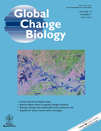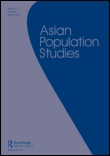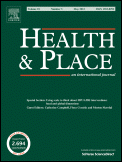
POPULATION AND ENVIRONMENT
Scope & Guideline
Fostering Knowledge at the Intersection of Society and Nature
Introduction
Aims and Scopes
- Population-Environment Interactions:
The journal prioritizes studies that examine how demographic changes, such as migration, fertility rates, and aging populations, impact environmental conditions and resource use. - Impact of Climate Change:
Research on the effects of climate change on human populations, including health outcomes, migration patterns, and socio-economic implications, is a core focus. - Social Vulnerability and Resilience:
The journal emphasizes the importance of social factors, such as inequality and vulnerability, in understanding how populations respond to environmental stressors. - Health and Environmental Quality:
It explores the relationship between environmental quality (e.g., air and water pollution) and public health, particularly among vulnerable populations. - Methodological Innovations:
The journal encourages the use of diverse methodologies, including quantitative modeling, qualitative research, and mixed methods, to address complex population-environment issues.
Trending and Emerging
- Climate Migration and Displacement:
An increasing number of studies focus on how climate change drives migration and displacement, emphasizing the need for understanding the socio-economic implications of these movements. - Health Impacts of Environmental Change:
There is a growing trend in exploring the health implications of environmental changes, particularly how climate and pollution affect vulnerable populations, including children and the elderly. - Social Inequality and Environmental Justice:
Research on environmental justice, particularly how socio-economic status influences vulnerability to environmental hazards, is gaining prominence. - Complex Household Dynamics:
Emerging studies are examining the complexity of household structures and their implications for environmental decision-making and resource management. - Integrated Approaches to Sustainability:
There is a notable increase in interdisciplinary research that integrates social, environmental, and economic factors to propose sustainable solutions to population-environment challenges.
Declining or Waning
- Historical Population Studies:
Research focusing on historical population dynamics and their environmental impacts has seen a decline, possibly overshadowed by more contemporary issues related to climate change. - Static Demographic Models:
There is a waning interest in traditional demographic models that do not account for environmental variables, as newer, integrated approaches gain popularity. - Single-Factor Analyses:
Studies that isolate single factors (like economic variables) without considering the broader environmental context are becoming less common, as the field moves towards more holistic analyses. - Urbanization Effects:
The focus on urbanization as a standalone theme is decreasing, with more emphasis now placed on rural and peri-urban interactions with environmental changes. - Disaster Recovery Studies:
Research specifically centered around disaster recovery processes is less frequent, as attention shifts to proactive measures and adaptation strategies.
Similar Journals

GLOBAL CHANGE BIOLOGY
Navigating the Complexities of Global Environmental ChangeGLOBAL CHANGE BIOLOGY, published by Wiley, is a leading journal dedicated to advancing the scientific understanding of the relationships between biological systems and global environmental changes. With an impressive impact factor placing it in the Q1 category across multiple disciplines—including Ecology, Environmental Chemistry, and Global and Planetary Change—this journal is essential for researchers, professionals, and students aiming to stay at the forefront of this dynamic field. The journal has a rich history since its inception in 1995, continually providing a platform for high-quality research that informs policy and management practices worldwide. Although it is not open access, the journal remains a valuable resource for those committed to exploring the complexities of ecological and environmental change. With a Scopus ranking of #3 in Global and Planetary Change and #6 in both Ecology and Environmental Chemistry, GLOBAL CHANGE BIOLOGY continues to shape the dialogue on the pressing environmental challenges of our time.

Spatial Demography
Connecting People and Places through Rigorous ResearchSpatial Demography is a vital academic journal published by Springer International Publishing AG, focusing on the intersection of spatial analysis and demographic research. With its ISSN 2364-2289 and E-ISSN 2164-7070, this journal aims to advance understanding of population dynamics through innovative methodologies and spatially explicit data, offering a platform for researchers, professionals, and students engaged in demography, geography, and urban studies. While it does not currently operate under an open access model, Spatial Demography maintains a rigorous peer-review process to ensure high-quality publications that contribute significantly to the field. Given the growing importance of spatial data in demographic research, the journal serves as an essential resource for those looking to explore how spatial attributes influence demographic processes and patterns worldwide. The official address of the publisher is Gewerbestrasse 11, Cham CH-6330, Switzerland.

Novedades en Poblacion
Connecting Research and Policy for Vibrant CommunitiesNovedades en Poblacion is a pivotal academic journal dedicated to the interdisciplinary exploration of demographic studies, population policies, and social dynamics, published by UNIV HABANA. Since its inception in 2005, this open access journal has provided a platform for researchers, professionals, and students to disseminate and discuss cutting-edge research and findings relevant to populations in Latin America and beyond. With a commitment to high-quality scholarship, Novedades en Poblacion plays a vital role in contributing to the global conversation on demographic changes, migration patterns, and socio-economic impacts on populations. Researchers are encouraged to submit original articles, reviews, and studies that advance the understanding of demographic issues, making it an essential resource for those engaged in the fields of sociology, public health, and urban studies.

Asian Population Studies
Pioneering Research in Asian DemographyAsian Population Studies is a distinguished journal published by Routledge Journals, Taylor & Francis Ltd, delivering comprehensive insights into the vibrant field of demography. Since its inception in 2006, this peer-reviewed journal has consistently provided a platform for high-quality research that enhances our understanding of population dynamics in Asia. With an impressive category ranking of Q2 in Demography for 2023, and holding a notable position as 35th out of 139 within the Scopus ranking, it is recognized for its significant contributions to the field, appealing to researchers, scholars, and professionals alike. The journal covers a diverse range of topics, including population growth, migration patterns, and socio-economic factors influencing demographic changes across Asian countries. Although it does not offer open access, Asian Population Studies remains a vital resource for those seeking to explore demographic trends and their implications for policy and practice in one of the most populous regions of the world. With a commitment to academic excellence, it continues to serve as an essential tool for anyone engaged in demographic research and study.

POPULATION RESEARCH AND POLICY REVIEW
Navigating the Complexities of Population DynamicsPopulation Research and Policy Review is a prestigious journal published by Springer, specializing in the fields of demography and policy analysis. Established in 1982, this journal has developed a significant reputation within the academic community, currently holding a Q1 ranking in Demography and a Q2 ranking in Management, Monitoring, Policy, and Law as of 2023. With a robust Scopus ranking of #34 out of 139 in Demography and a readership that spans multiple disciplines, this journal serves as a critical platform for researchers, professionals, and policymakers to disseminate their findings and insights related to population dynamics and policy implications. Although not an open-access journal, Population Research and Policy Review provides vital research that influences both theoretical frameworks and practical applications in social sciences and environmental management. The journal’s ongoing commitment to high-quality, peer-reviewed scholarship makes it an indispensable resource for those seeking to understand and address contemporary demographic challenges.

Espaces-Populations-Societes
Bridging the Gap Between Population Studies and Spatial PlanningEspaces-Populations-Sociétés is a distinguished journal published by UNIV LILLE I SCI & TECH, focusing on the fields of demography and geography. Established in 1983, this open-access journal has committed itself to providing a platform for innovative research and discussions around population dynamics and spatial organization, with accessibility to its content available since 2004. Based in France, at the UFR Géographie & Aménagement, the journal plays a crucial role in advancing understanding of demographic trends and planning developments. With current Scopus rankings highlighting its position in the 25th and 14th percentiles for Demography and Geography, Planning and Development respectively, it maintains a reputable standing within academic circles, establishing its importance in contemporary research landscapes. Researchers, professionals, and students alike will find valuable insights in its comprehensive overview of sociocultural and environmental interactions, as well as place-based issues at the heart of societal development.

HEALTH & PLACE
Advancing Understanding of Health in Diverse PlacesHEALTH & PLACE is a premier academic journal published by Elsevier Science Ltd, focusing on the intersection of health and geographical contexts. With an impressive impact factor and a Q1 classification across multiple categories including Geography, Health (Social Science), and Public Health, this journal serves as an essential platform for disseminating groundbreaking research and innovative insights into how place influences health outcomes. Established in 1995, HEALTH & PLACE offers a comprehensive view of contemporary health challenges through a social science lens, making it invaluable for researchers, practitioners, and policymakers alike. Although it operates under a traditional subscription model, the high visibility afforded by its ranking—elevating it to the top tier of its field—ensures that its rigorous peer-reviewed articles reach a wide audience. With a convergence of critical topics relevant to life-span studies and environmental health, the journal not only enriches academic discourse but also informs practical applications in public health initiatives.

POPULATION
Unpacking the Complexities of Population StudiesPopulation, an esteemed journal published by the Institut National d'Études Démographiques (INED), serves as a critical platform for the dissemination of high-quality research in the field of demography. With the ISSN 0032-4663 (Print) and E-ISSN 1957-7966 (Online), this journal covers a wide spectrum of topics related to population studies, including migration, fertility, mortality, and population policy, offering a comprehensive lens on demographic trends that influence societies worldwide. Although it operates under a traditional subscription model, its rigorous peer-review process ensures that only the most impactful and relevant research findings are published. With its long-standing reputation among scholars and practitioners in the demographic domain, Population plays a vital role in shaping the academic discourse and guiding future research directions. Scholars, professionals, and students alike will find in its pages not only innovative perspectives but also critical insights that reflect the complexities of population dynamics in a rapidly changing world. For those dedicated to understanding the demographic challenges that societies face today, this journal remains an invaluable resource.

POPULATION ECOLOGY
Connecting researchers to enhance understanding of ecological processes.Population Ecology is a leading journal dedicated to the advancement of research in the field of ecology, evolution, and behavior, published by the esteemed Wiley in Japan. With an impact factor indicative of its academic significance and ranked Q2 in the 2023 Ecology category, this journal serves as a pivotal resource for researchers, professionals, and students alike, facilitating the dissemination of high-quality research and innovative discussions. Covering diverse aspects of ecological dynamics, population processes, and their evolutionary implications, Population Ecology fosters a deeper understanding of species interactions and environmental factors shaping ecosystems. Available in both print and online formats (E-ISSN 1438-390X), the journal is committed to open access to enhance public engagement and accessibility to crucial scientific findings, ultimately contributing to informed decision-making regarding biodiversity and conservation efforts. With a robust ranking of #235 out of 721 in Agricultural and Biological Sciences, it is poised to remain at the forefront of ecological research through 2024 and beyond.

Chinese Journal of Population Resources and Environment
Pioneering Insights into Population Dynamics and Resource ManagementChinese Journal of Population Resources and Environment is an esteemed interdisciplinary journal published by KEAI PUBLISHING LTD, focusing on the critical intersections of population dynamics, resource management, and environmental sustainability. With an E-ISSN of 2325-4262 and an ISSN of 2096-9589, this Open Access journal has been committed to disseminating high-quality research since its inception in 1992 and has embraced Open Access since 2020. As part of its robust reputation, the journal ranks in the Q1 category for Demography and is recognized in the Q2 tiers for both Environmental Science and Toxicology, reflecting its significant contribution to these fields. The 2023 Scopus rankings highlight its competitiveness, with an impressive percentile of 84th in Demography and 67th in Environmental Science (miscellaneous). Hosted from Beijing, China, the journal serves as a vital platform for researchers, professionals, and students to engage with cutting-edge studies that address pressing global challenges related to population and environmental resources.